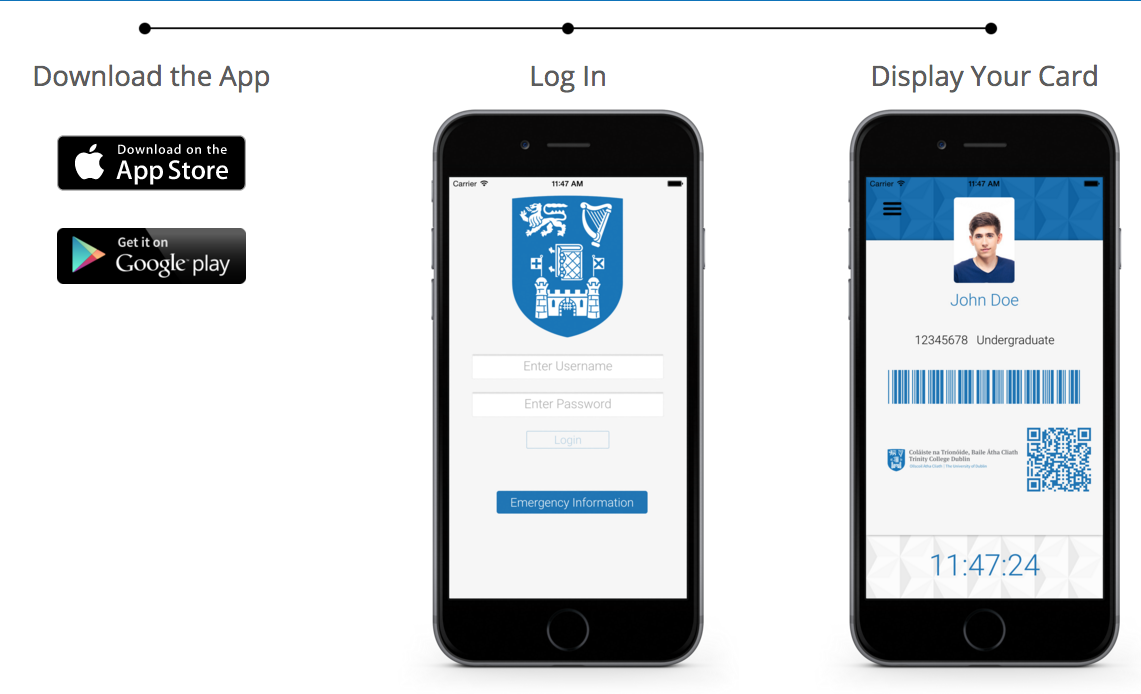
The idea of providing a digital ID came to fruition last year during Finn Murphy’s tenure as entertainment officer of the SU. During his research into the possible interest into the production of such an app for students, an email survey was forwarded to students in which they were questioned about Murphy’s proposal. The respondents of the online survey proved to be extremely positive towards the idea with over 91.6% agreeing that it would be of value to their college experience. The overwhelmingly encouraging response prompted a collaboration between the Trinity College Dublin Students Union, the School of Computer Science and Statistics, and IT Services. At the centre of this project were two third year Computer Science students, Conor Brennan and Peter Meehan, who developed the app over the summer.
The pair first became acquainted with project when they were referred to Computer Science lecturer Stephen Weber. This selection process began in early May and the students began initial work on the app by the end of the month. For the first month or two, the instructions given to Brennan and Meehan were simply “go off and do it.” They explain: “We were given an office in the Lloyd from SCSS but for the first month or two there was very little direction, so we went off and made the thing with a sort of stubbed out version of the college infrastructure.” However, as the calendar changed, so too did the involvement of the college staff as they endeavoured to finish the project: “The last month and a half of it was more tightly regulated where we were actually trying to get it to work with IT Services systems. There was a lot of management, jumping through sort of bureaucratic hoops and trying to make the thing official.”
As well as working on the app itself, it became the job of Brennan and Meehan to secure funding from College. Brennan mentions that the pair gleaned a clear insight into the strange situation, in relation to gathering support for such projects: “After working on it for a month and a half we were then being asked to go off and get the funding for the thing we were already working on.” Targeted sources included the library, the sports centre, security, academic registry, careers advisory service and the counselling service. “Seemingly it’s not enough for the Provost to just say “this is a thing”, you have to go and ask each of the stakeholders individually whether they want to use the thing. We had to go and meet them individually and say “this is a thing now, is it okay with you that it’s a thing?”, as opposed to “the Provost has said this is a thing, you’re going to have to use it.” It was weird; I thought that dynamic was really odd.”
During the three months allocated to complete the project, they focused on providing several key features to students: “We started with the ‘if you lose or forget your student card, it lets you say who you are,’ so within that it really just generates an image and shows who you are.” The students also added a Dublin map and a Twitter feed. However, they also experienced restrictions. One of these was in relation to the NFC (near field communication), a process in which technology would be used to open doors using student cards. “That was taken off the table really early on, because you can’t develop it for iOS. It would have been possible for a lot of Android phones, but we were told not to do that because we can’t have a different version for iOS and a different version for Android.”
Brennan and Meehan’s time at the helm of the digital ID app has almost reached its conclusion. After some uncertainty, the pair are currently in the process of passing the torch onto IT Services: “I think IT Services are the people who are going to own the code base and it’ll be people there who’ll maintain it.” The pair also have a lot of thoughts on what new features could be added to the app in the future, including the hopeful inclusion of NFC: “If Apple release NFC to developers, then definitely building access is the first thing they want to go into it.” Other stakeholders around the college also provided the students with other possibilities of what they would like to see included within the app, for example to see if the student identifiable from the app was an international student or a resident of Trinity accommodation.
However, Brennan and Meehan have some qualms with the college infrastructure services, in relation to implementing these minor changes to the app. Brennan clarifies: “The way college has all of their infrastructure set up, the way the data lies and who owns the data, it makes it all a big spaghetti mess in terms of trying to collate everything together, stuff you’d think would be really simple.” Yet the pair are confident that the app’s success could guarantee the college’s future investment into the project: “If people go and download and use it and it’s seen to be used, the college will probably put money towards it, so you could make it as big or as full-featured as you liked, and I suppose they like the idea of people having a Trinity-branded thing on their phones.”
Additional reporting by Jason Leonard






